The All-American Canal may deliver across the border
CALEXICO, CALIF. â Whatâs in a name? When it comes to the All-American Canal, apparently everything.
Built in the 1930s, the 80-mile-long canal brings water from the Colorado River to the farmland of the Imperial Valley, transforming a rocky desert in Californiaâs southeast corner into one of the worldâs most bountiful agricultural regions. It replaced a canal in Mexico that once ferried water west and supplied farmers on both sides of the border.
By building a new canal entirely in the U.S., Imperial Valley farmers and landowners, and the politicians who supported them, were asserting independence from their southern neighbor and, indirectly, claiming dominance over the river.
Now, nearly eight decades later, the U.S. government has called for using the All-American Canal to deliver water to Mexico via what engineers call a turnout at Calexico -- in effect, a ditch leading to the Mexicali Valley and the Tijuana aqueduct.
The idea does not sit well with farmers and officials in the Imperial Valley who believe that powerful outsiders are again ignoring the valleyâs hard-fought water rights, this time in an effort to improve relations with the Mexican government.
âThereâs a reason itâs called the All-American Canal,â said Kevin Kelley, general manager of the Imperial Irrigation District, raising his voice for emphasis.
The binational deal signed Tuesday that includes the turnout idea left open a key question: At times of peak demand -- say, in the middle of growing season -- whose water request would get priority: Mexicoâs or the Imperial Valleyâs?
Imperial Irrigation District engineers say the canal is already running at capacity, an assertion key federal officials find unconvincing.
âThis is such a historic arrangement that I think at the end of the day it is going to be difficult for Imperial not to sign on,â Interior Secretary Ken Salazar said at a signing ceremony that was boycotted by officials from the Imperial Irrigation District.
The federal government vows to âexpediteâ the environmental review and permitting application, the kind of process that can take years.
There are numerous environmental and engineering issues that will need to be studied, said Imperial Irrigation District attorney John Carter.
Once the review process begins, will planning for the turnout bring angry denunciations from Imperial Valley farmers?
âThat will be a common reaction,â said Carter, one of the stateâs top water-issue lawyers.
The Imperial Irrigation District operates the All-American Canal, but the canal is owned by the Bureau of Reclamation, the federal agency that also controls the Colorado River and makes crucial decisions about when drought conditions require cutbacks in allocations.
Although they did not like many of its details, two longtime board members of the Imperial Irrigation District, Stella Mendoza and John-Pierre Menvielle, sought to convince other members that it was in the districtâs best interests to join water agencies from Arizona, Nevada and Southern California in signing the deal. That effort failed on a 2-2 vote.
âYou can get emotional about it, but itâs going to happen anyway,â Mendoza said. âWhy not be good neighbors with Mexico? We need a good relationship with the bureau.â
But that sense of dependence on outsiders is anathema to many in the Imperial Valley farming community, where the self-image is large on rugged individualism. Mendoza and Menvielle were recently defeated for reelection by candidates asserting they had not done enough to protect the rights and needs of farmers.
The five-year binational deal amends the 1944 treaty that divided up annual allocations from the Colorado River to Mexico and seven western states in the U.S.
Mexico will get $10 million to fix its earthquake-damaged canal system by agreeing to sell water to regional agencies in Southern California, Arizona and Nevada. The Metropolitan Water District of Southern California will receive 47,500 acre-feet of water -- enough to satisfy the needs of 95,000 families for a year -- by paying half of the $10 million.
The U.S. will buy additional water from Mexico for the Mexican delta on the edge of the Gulf of California, to the delight of environmentalists and fishermen. Mexico, in exchange for agreeing to endure cutbacks during times of shortage, gets the right to store water at Lake Mead, the reservoir behind Hoover Dam.
Imperial maintains that the Mexican water being sold to the U.S. should be considered an addition to the U.S. allocation and thus divided up according to the 1944 treaty. That agreement gives the Imperial Irrigation District a higher priority than the Metropolitan Water District. Imperial farmers also have senior rights to the biggest allocation of water on the 1,400-mile length of the Colorado River, which empties into the Mexican delta leading to the Gulf of California.
Still, memories are long in the farming community, where some families came to the Imperial Valley from the Owens Valley decades ago when the water supply there was diverted for use in Los Angeles.
The late Rick Mealey, farmer, dairy rancher and unofficial poet laureate of the Imperial Valley, wrote about how âthis valley died too soonâ when powerful outsiders decided that the water âwasnât ours/And they needed it somewhere else/for amusements parks and power.â
Mealeyâs verse reflected a belief among farmers that politicians and water officials representing urban areas are forever looking with thirsty eyes at the Imperial Valleyâs share of the Colorado River.
In January, the Imperial Irrigation District warned the Bureau of Reclamation that it might withhold its support of the binational pact, including the turnout idea.
In the end, the warning was to no avail. At a ceremony at the Hotel del Coronado near San Diego, the pact was signed Tuesday by officials from both countries amid a feeling of binational bonhomie.
In the Imperial Valley, farmers, water district officials and their lawyers were left to consider their next move.
--
More to Read
Sign up for Essential California
The most important California stories and recommendations in your inbox every morning.
You may occasionally receive promotional content from the Los Angeles Times.









